Adventures in Africa
Chapter 8 - Tanzania: Volcano-Land I - Mt. Meru
We are on the shuttle bus to Arusha, Tanzania. A
wealthy lady is sitting nearby with duty free bags from Dubai. She
bought almost everything - a microwave oven, a toaster, many
clothes and much more. Just before the border she covers her things
with old blankets and gets off the bus. In the border we stamp our
passports and go back to the bus. The woman joins us only 500 meters
later on. We continue 2 more km and the bus is stopped by a special
customs unit. After a brief checking of the bus they discover that the
lady is smuggling her belongings. They talk with her and after a quick
negotiation agree to take the microwave oven from her. No, the woman
did not pay tax, she has just bribed the customs.
Welcome to Tanzania.
What we have just seen is a typical example of what is
going on in this corrupt country. Kenya and Uganda, in comparison with
Tanzania, are European countries. What we don't like here is the
attitude of the government towards the tourists. The park entrance
fees are sky high. Only US dollars are accepted, and there are no
reductions for anybody: small children, students, seniors - all are
white and hence rich. A daily entrance fee to the Serengeti National
Park is 4 times more expensive than to the Masai Mara. Entrance fees
to climb Mt. Meru are 5 times more expensive than of Mt. Kenya. In
order to ascent the Kilimanjaro you have to spend at least 500$.
If the money went to the protection of the parks or of
nature, maybe we would accept it somehow, but it's not the
case. Most of the money goes directly to the Swiss private bank
accounts of the president.
We arrive at Arusha, the second biggest town in
Tanzania. We go strait to a hotel recommended to us by some
Israelis. As usual with the Israeli recommendations, the hotel is
located in the market (Like Hare Rama hotel, in the main bazaar, New
Delhi). On one hand the neighborhood is dirty, on the other hand
itĘs in the middle of town. Strolling in the streets of Arusha is
not that pleasant.
The Tanzanians are not as violent as the Kenyans are,
but are discovered to be very sticky. If they want to sell you
something or bag money from you, they will walk after you for
hours. The only thing we are interested at, is information how to get
and climb Ol Doinyo Lengai. This mountain is an active volcano where
it is possible sometimes to see rivers of lava. In our guide book
it's written that "When you finally reach the crater rim, the
hard slog is worth it. You can look down into the crater and see steam
outlets and the growing cones of volcanic ash. Obviously, this is a
VERY dangerous area, and although people do it, dropping down to the
crater floor is not advised". The mountain's name means in the
Masai language "Mountain of God". We understand that the
mountain is located in a very remote area, not far from the southern
shores of Lake Natron. Lake Natron is a soda lake (i.e. filled with
shallow water with high content of minerals) where a famous battle
between the British and the German took place (it is mentioned in the
movie "Out of Africa"). We must hire a FWD (4x4) vehicle in
order to get there. We decide to organize a group of people, in order
to lower the costs, and we put ads in some of the backpackers'
hotels.
|
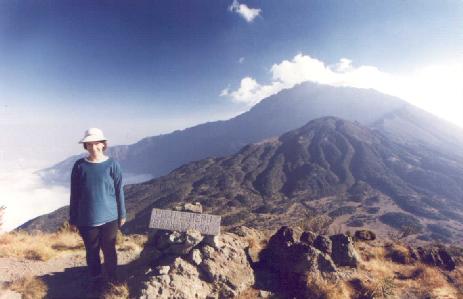
|
Meanwhile we go to climb Mt. Meru, at 4,567m'. Not
like the two other volcanoes we have already climbed, Mt. Elgon and
Mt. Kenya, this volcano is not extinct. In fact, it has erupted
several times in the last 100 years. The mountain is an almost perfect
cone with an internal crater, or caldera, surrounded by steep wall of
cliffs. At about 2,500m' the wall has been broken away so the top
half of the mountain is shaped like a giant horse shoe. The cliffs of
the inner wall below the summit are over 1,500m' high which makes
them among the tallest in Africa. Inside the crater more recent
volcanic eruptions have created a subsidiary peak called the Ash
Cone. |
|
At about 2,500m' the wall has been broken away so the top
half of the mountain is shaped like a giant horse shoe. |
|
We take a bus from town to the junction with the road
leading to the Arusha National Park, from where we hitch to Momella
Gate (at 1,500m'), the starting point. We pay entrance fees (which
include an escort of an armed ranger who is supposed to protect us
from dangerous animals) and take a porter to help us with the bags. We
start to walk in a beautiful dense forest and arrive to the lower hut
at 2,500m'). There are about 40 people there, 90% of them are
German, in the middle of a kind of a party - smoking cigarettes and
drinking a lot of beer. We talk with a guide of an organized group
from England. He tells us that most of the people in the hut,
including his group, don't attempt to climb the summit at
all. It's too much of an effort. They come only to see the forest
and animals and the following day they will go down. I ask him if he
knows Ol Doinyo Lengai. Yes he has been there. He says it's
amazing. And (I remember exactly what he said!) that "It's
bubbling nicely up there". He says that he envies us very much that
we will climb the volcano. He would go with his group if they were
fit, but they aren't. |
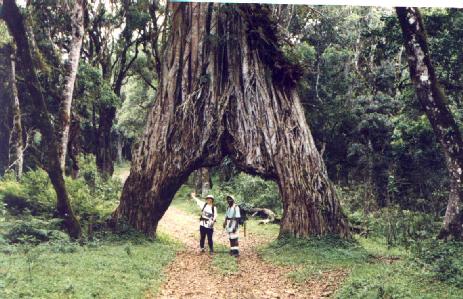
|
|
We
start to walk in a beautiful dense forest. |
Next day it's drifting, and we climb the slippery
mud, till we get out of the forest and the clouds at the same time. We
arrive to the second hut, Saddle hut (3,570m') at early
afternoon. We leave our bags, as well as our ranger (there are no
dangerous animals up here) and climb Little Meru (3,820m'). From
the top there are impressive views of Meru summit, the horse shoe
crater, the top of the ash cone and the sheer cliffs of the
crater's inner wall. In the other direction, across the top of the
clouds, we see the great dome of Kilimanjaro. We go down to the
hut. We are there only with one more team of 4 Germans. At 2
o'clock at night we wake up, drink tea, eat some biscuits and start
to walk. Our ranger is "feeling sick", so the porter takes the
guidance. The ascent is steep. We walk to the light of our torch
lights. Except from the path, several meters in front of us, and the
stars we see nothing. Sometimes the ground is so sandy that every step
we go up, we slide down half of it. The Germans get tired so we break
the group into two. After 4 hours of almost non-stop walk, at about
dawn, we arrive to the top. The sun is rising behind the Kilimanjaro,
the clouds are laying thick below us and we are exhilarated by the
stunning views.
|
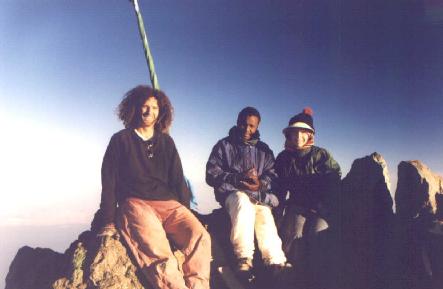
|
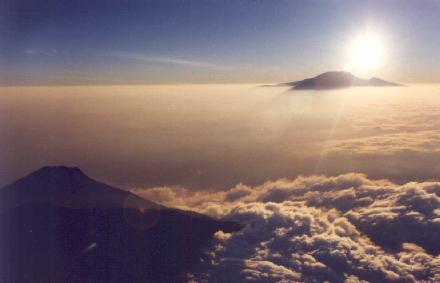
|
|
After 4 hours of almost non-stop walk, at about
dawn, we arrive to the top. |
Across the top of the clouds, we see the great dome of Kilimanjaro. |
In the evening, Tali and I celebrate the successful
ascent eating in "Pizza Arusha". It's a restaurant with very
a peculiar design: it's made of wood, the roof is made of straw
(yes, there isn't much rain in Arusha), there is no glass in the
windows and above all, there is no electricity - everything is lit
by candles. The service is not less bizarre: the waitress is a very
positive girl - if she doesn't understand something she says
only "yes". In the end we wrote down our order on a piece of
paper and she took it to the English speaking cook, who is also the
owner. The waitress doesn't like to say no, so when we order "a
glass of milk" we get an empty glass ("milk is finished but we have
a glass..."). But the most important thing they do have there is
excellent food (marvelous thin and crispy pizzas!).
|
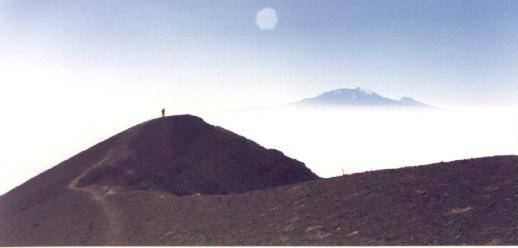
|
The last 24 hours were the most enjoyable for us in
Africa so far: It started with 4 hours climb at night. Continued with
a sun-rise-over-the-Kilimanjaro break. Then 2 hours going back down
while walking on the giant crater rim (The views of the Kilimanjaro
and the ash cone could be fully appreciated). In 5 more hours we
completed more than 3,000 meters of a vertical drop till Momella
gate. Then a hitch back to town, and here we are in Pizza Arusha! |
|
Walking on the giant crater rim. |
The following day we find an Israeli couple, "uncle"
Yair and "uncle" Moshe, who are willing to go with us to climb Ol
Doinyo Lengai. The trip will consist of 3 days. In the first day we
will have a game drive in Ngorongoro National Park. Day 2 will be a
long drive to Lake Natron and we will have a walk to see the
waterfalls of Ngare Sero river. In the evening we will climb Ol Doinyo
Lengai and with a bit of luck will see the red lava. On the last day
we will explore Lengai's crater and then return all the way to
Arusha.
We go to sleep very excited dreaming about the
trip...
Last modified: Sat Jun 12th 20:05:00 IST 1999




